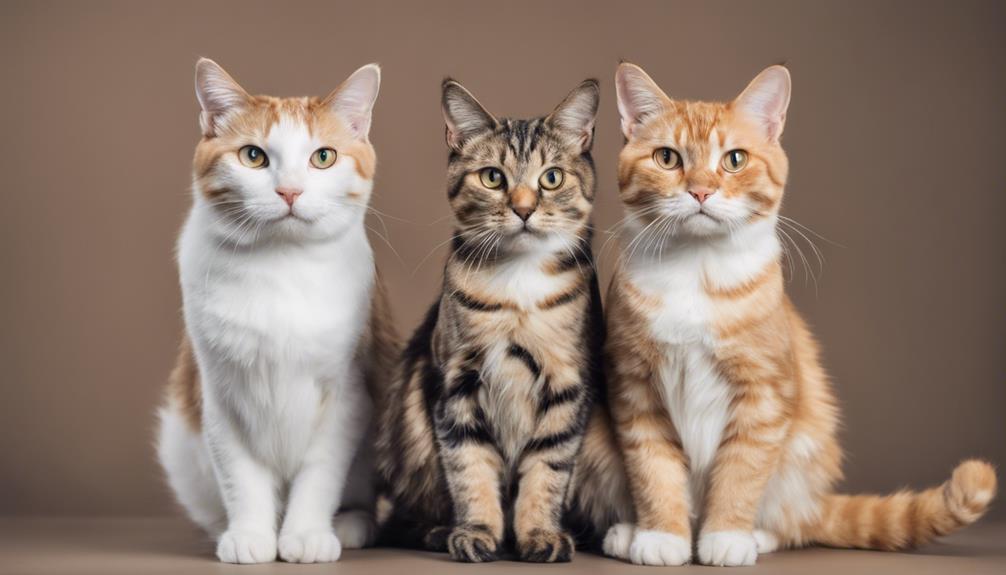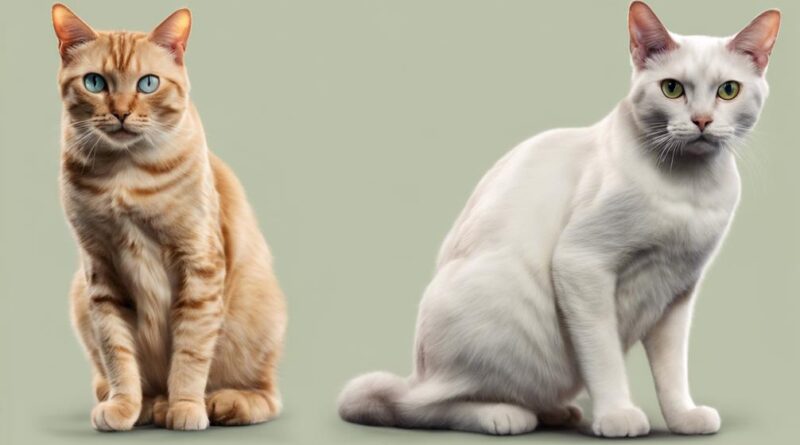5 Tips: Inbreeding Effects on Cat Genetics
When it comes to inbreeding in cats, think of it as a genetic puzzle with pieces that may not fit quite right. The effects can be subtle yet impactful. From health concerns to the risk of inherited disorders, the implications of inbreeding are far-reaching.
But fear not, as there are strategies and precautions that can be taken to navigate these genetic complexities. By exploring the tips and insights offered, you can gain a deeper understanding of how inbreeding influences cat genetics and discover potential solutions to maintain healthy feline populations.
Understanding Inbreeding in Cats
If you breed cats from closely related parents, you increase the likelihood of genetic disorders. This is where pedigree analysis plays a crucial role. By examining the lineage of a cat, you can identify any potential genetic issues that may arise from inbreeding. Pedigree analysis helps breeders understand the genetic makeup of their cats, allowing them to make informed decisions when it comes to breeding.
Breeding restrictions are often put in place to prevent inbreeding and maintain genetic diversity within cat populations. These restrictions help ensure that cats are bred with unrelated individuals, reducing the risk of passing on harmful genetic traits. By following breeding restrictions, breeders can help minimize the occurrence of genetic disorders and promote healthier cats overall.
Understanding the implications of inbreeding through pedigree analysis and adhering to breeding restrictions are essential steps in responsible cat breeding. By considering the genetic background of cats and breeding them with unrelated partners, you can help preserve the health and vitality of future generations. Remember, being mindful of the genetic diversity within cat populations is key to promoting the well-being of these beloved animals.
Impact on Genetic Diversity
To grasp the significance of inbreeding effects on cat genetics, it's imperative to consider the impact on genetic diversity within cat populations. Genetic diversity refers to the variety of different genes in a population, and it plays a crucial role in the overall health and adaptability of a species. When inbreeding occurs, it reduces genetic variation within the population, as individuals are more likely to inherit the same genetic material from both parents. This lack of genetic diversity can have detrimental effects on population health.
Genetic variation is essential for a population to withstand environmental changes, diseases, and other challenges. A diverse gene pool allows for a greater likelihood of some individuals possessing beneficial traits that can help the population survive and thrive. Inbreeding diminishes this genetic variation, increasing the risk of inherited disorders and reducing the ability of the population to adapt to new conditions.
Maintaining genetic diversity is crucial for the long-term sustainability of cat populations. By avoiding inbreeding practices, breeders and cat owners can help preserve genetic variation, ultimately promoting population health. It's important to prioritize genetic diversity in breeding programs to ensure the well-being and resilience of cats for generations to come.
Health Risks of Inbreeding
Inbreeding poses significant health risks to cat populations due to the increased likelihood of inheriting harmful genetic traits from closely related individuals. When cats are bred with close relatives, the chances of genetic abnormalities and inherited disorders significantly rise. These defects can manifest in various ways, impacting the overall health and well-being of the offspring.
Breeding restrictions play a crucial role in mitigating the health risks associated with inbreeding. By implementing regulations that discourage mating between closely related cats, breeders can help maintain genetic diversity and reduce the prevalence of harmful traits within cat populations. It's essential for breeders to prioritize the health of their cats over other considerations to prevent the perpetuation of detrimental genetic conditions.
Genetic counseling can also provide valuable guidance to breeders looking to minimize the health risks of inbreeding. Consulting with professionals who specialize in cat genetics can help breeders make informed decisions about mating pairs, identify potential risks, and develop strategies to promote healthier breeding practices. Through genetic counseling, breeders can gain a deeper understanding of the genetic makeup of their cats and take proactive steps to safeguard the well-being of future generations. By adhering to breeding restrictions and seeking genetic counseling, breeders can help protect cat populations from the detrimental effects of inbreeding.
Inherited Genetic Disorders
In cat populations affected by inbreeding, inherited genetic disorders present a significant concern for breeders and the overall health of the feline community. Carrier screening and genetic counseling play crucial roles in identifying these disorders early on. By conducting thorough pedigree analysis, breeders can pinpoint specific genetic issues within their lines and make informed decisions through selective breeding practices.
Carrier screening is a fundamental tool used to detect genetic disorders in cats. By identifying carriers – individuals with a copy of a mutated gene but not displaying the disease – breeders can avoid mating two carriers to prevent the disorder from manifesting in future generations. Genetic counseling provides breeders with valuable information on the risks associated with specific genetic disorders and aids in making responsible breeding choices to minimize the spread of these conditions.
Pedigree analysis is essential for understanding the inheritance patterns of genetic disorders in cat populations. By tracing the lineage of affected cats, breeders can determine the prevalence and heritability of certain disorders. This knowledge enables breeders to selectively breed cats without the genetic predisposition for these disorders, ultimately reducing their occurrence in future litters.
Managing Inbreeding in Breeding Programs
Utilize genetic diversity strategically to manage inbreeding effectively in your breeding programs. When it comes to breeding ethics and genetic health, it's crucial to take proactive steps to prevent inbreeding and promote genetic diversity within your breeding programs.
Here are three key strategies to help you navigate the complexities of managing inbreeding:
- Implement outcrossing: Introduce unrelated individuals into your breeding pool to increase genetic diversity and reduce the potential negative effects of inbreeding. Outcrossing can help dilute harmful recessive genes and improve overall genetic health in your cat population.
- Monitor coefficient of inbreeding: Regularly assess the coefficient of inbreeding in your breeding lines to avoid excessively high levels of inbreeding. By keeping this metric in check, you can make informed decisions to maintain genetic variability and minimize the risk of inherited genetic disorders.
- Collaborate with other breeders: Engage with other breeders to exchange knowledge, genetic resources, and breeding practices. Collaborative efforts can offer opportunities to introduce new genetic lines, share best practices for inbreeding prevention, and collectively work towards the long-term sustainability of your breeding programs.
Outbreeding as a Solution
Introducing genetically diverse individuals into your breeding programs can effectively mitigate the risks associated with limited genetic variability, promoting healthier cat populations in the long run. Outbreeding, which involves mating individuals from different lineages or breeds, brings about several benefits to cat genetics. By outbreeding, you can increase genetic variation within your breeding lines, reducing the chances of inherited disorders and enhancing overall vitality in your feline companions.
Outbreeding benefits your cats by introducing new gene combinations, which can lead to a more robust immune system and increased disease resistance. This genetic diversity also helps in maintaining desirable traits within cat breeds while minimizing the prevalence of harmful genetic mutations. Moreover, outbreeding can improve fertility rates and litter sizes, ensuring the sustainability of your breeding program over generations.
Genetic Testing for Breeders

To enhance the quality and health of your breeding program, consider implementing genetic testing for breeders. Genetic testing can provide valuable insights into the genetic makeup of your cats, helping you make informed breeding decisions.
Here are some key points to consider:
- Genetic Counseling: Seek guidance from a professional genetic counselor to interpret the results of the genetic tests accurately. Genetic counselors can help you understand the implications of certain genetic traits within your breeding population and assist in developing effective breeding strategies to minimize the risk of inherited disorders.
- Breeding Strategies: Utilize the information obtained from genetic testing to implement effective breeding strategies. By selectively breeding cats based on their genetic profiles, you can work towards improving the overall health and genetic diversity of your breeding program. This targeted approach can help reduce the incidence of genetic disorders and enhance desirable traits in future generations.
- Continual Monitoring: Genetic testing should be an ongoing process in your breeding program. Regularly test new breeding cats to ensure that you're making informed decisions based on the most up-to-date genetic information. By continually monitoring the genetic health of your breeding cats, you can adapt your breeding strategies to maintain a healthy and genetically diverse population.
Future of Cat Genetics
As you aim to advance your breeding program, staying abreast of emerging trends and advancements in cat genetics will be crucial for ensuring the long-term success and sustainability of your breeding efforts. The future of cat genetics holds exciting possibilities, with genetic engineering playing a significant role. Breeders are increasingly exploring the option of using genetic engineering techniques to enhance desirable traits or eliminate genetic diseases within cat populations. However, ethical considerations surrounding the manipulation of genes in cats must be carefully weighed to ensure the well-being of the animals.
In contemplating the future of cat genetics, it's essential to consider the evolutionary implications of breeding practices. While selective breeding has been the primary driver of feline genetic diversity in domestic cats, it's important to remember the role of natural selection in shaping genetic traits over time. As breeders, understanding how natural selection operates and how it can influence the genetic health of cat populations is crucial for maintaining the overall viability and resilience of different breeds.
Frequently Asked Questions
How Can Breeders Ensure That Inbreeding Does Not Negatively Impact the Overall Health and Well-Being of the Cat Population?
To prevent inbreeding from harming cats' health, you should use genetic testing and pedigree analysis.
Monitor their health closely and adjust breeding practices accordingly.
Are There Any Specific Genetic Disorders That Are More Common in Certain Cat Breeds Due to Inbreeding?
When breeding closely related cats, inbreeding risks increase, leading to specific genetic conditions more prevalent in certain breeds. These breed-specific disorders are a result of inbreeding effects on the gene pool, potentially impacting the overall health of the cat population.
It's crucial for breeders to be aware of these risks and work towards diversifying the gene pool to mitigate the negative consequences of inbreeding on cat genetics.
What Are Some Potential Long-Term Consequences of Continued Inbreeding Within a Specific Cat Breed?
Continued inbreeding in a specific cat breed can lead to reduced genetic diversity and increase the likelihood of inherited health issues.
It's crucial to monitor the health of breeding cats and conduct pedigree analysis to identify potential problems.
By diversifying breeding practices and avoiding close relatives, you can help maintain the long-term health and vitality of the breed.
Stay vigilant and prioritize genetic health to ensure a thriving feline population.
Are There Any Alternative Methods for Maintaining Genetic Diversity in Cat Populations Aside From Outbreeding?
To maintain genetic diversity in cat populations beyond outbreeding, consider selective breeding. This method allows for focusing on desirable traits while avoiding inbreeding.
How Can Cat Owners Identify Potential Genetic Health Issues in Their Pets That May Be Related to Inbreeding?
To identify potential genetic health issues related to inbreeding in your cat, start with health screening and genetics testing. Regular vet check-ups can catch early signs.
Learn about your cat's breed and its common genetic problems. Be cautious of breeding practices that prioritize appearance over health. Consider genetic diversity when choosing a mate.
Stay informed to promote your cat's well-being and prevent genetic issues.
Conclusion
In conclusion, understanding the effects of inbreeding on cat genetics is crucial for breeders and cat owners alike. By being aware of the impact on genetic diversity, health risks, and inherited genetic disorders, steps can be taken to manage inbreeding in breeding programs.
Utilizing outbreeding and genetic testing can help ensure the future health and well-being of cat populations. Stay informed and proactive in maintaining genetic diversity to promote the overall health of our feline friends.
